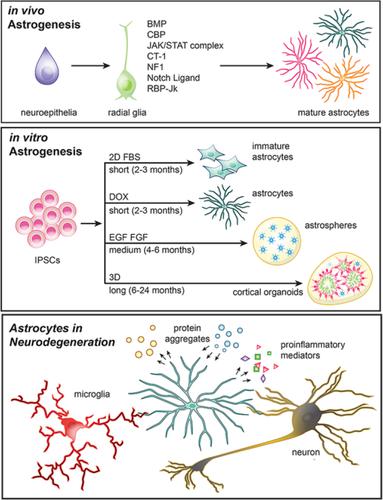Our official English website, www.x-mol.net, welcomes your feedback! (Note: you will need to create a separate account there.)
An update on human astrocytes and their role in development and disease.
Glia ( IF 6.2 ) Pub Date : 2020-01-11 , DOI: 10.1002/glia.23771 Martina de Majo 1 , Mark Koontz 1 , David Rowitch 2, 3, 4 , Erik M Ullian 1
Glia ( IF 6.2 ) Pub Date : 2020-01-11 , DOI: 10.1002/glia.23771 Martina de Majo 1 , Mark Koontz 1 , David Rowitch 2, 3, 4 , Erik M Ullian 1
Affiliation

|
Human astrocytes provide trophic as well as structural support to the surrounding brain cells. Furthermore, they have been implicated in many physiological processes important for central nervous system function. Traditionally astrocytes have been considered to be a homogeneous class of cells, however, it has increasingly become more evident that astrocytes can have very different characteristics in different regions of the brain, or even within the same region. In this review we will discuss the features of human astrocytes, their heterogeneity, and their generation during neurodevelopment and the extraordinary progress that has been made to model these fascinating cells in vitro, mainly from induced pluripotent stem cells. Astrocytes' role in disease will also be discussed with a particular focus on their role in neurodegenerative disorders. As outlined here, astrocytes are important for the homeostasis of the central nervous system and understanding their regional specificity is a priority to elucidate the complexity of the human brain.
中文翻译:

人类星形胶质细胞及其在发育和疾病中的作用的最新进展。
人类星形胶质细胞为周围的脑细胞提供营养和结构支持。此外,它们与许多对中枢神经系统功能很重要的生理过程有关。传统上,星形胶质细胞被认为是一类同质细胞,然而,越来越明显的是,星形胶质细胞在大脑的不同区域甚至同一区域内可能具有非常不同的特征。在这篇综述中,我们将讨论人类星形胶质细胞的特征、它们的异质性和它们在神经发育过程中的产生,以及在体外模拟这些迷人细胞(主要来自诱导性多能干细胞)方面取得的非凡进展。还将讨论星形胶质细胞在疾病中的作用,特别关注它们在神经退行性疾病中的作用。
更新日期:2020-01-13
中文翻译:

人类星形胶质细胞及其在发育和疾病中的作用的最新进展。
人类星形胶质细胞为周围的脑细胞提供营养和结构支持。此外,它们与许多对中枢神经系统功能很重要的生理过程有关。传统上,星形胶质细胞被认为是一类同质细胞,然而,越来越明显的是,星形胶质细胞在大脑的不同区域甚至同一区域内可能具有非常不同的特征。在这篇综述中,我们将讨论人类星形胶质细胞的特征、它们的异质性和它们在神经发育过程中的产生,以及在体外模拟这些迷人细胞(主要来自诱导性多能干细胞)方面取得的非凡进展。还将讨论星形胶质细胞在疾病中的作用,特别关注它们在神经退行性疾病中的作用。



























 京公网安备 11010802027423号
京公网安备 11010802027423号